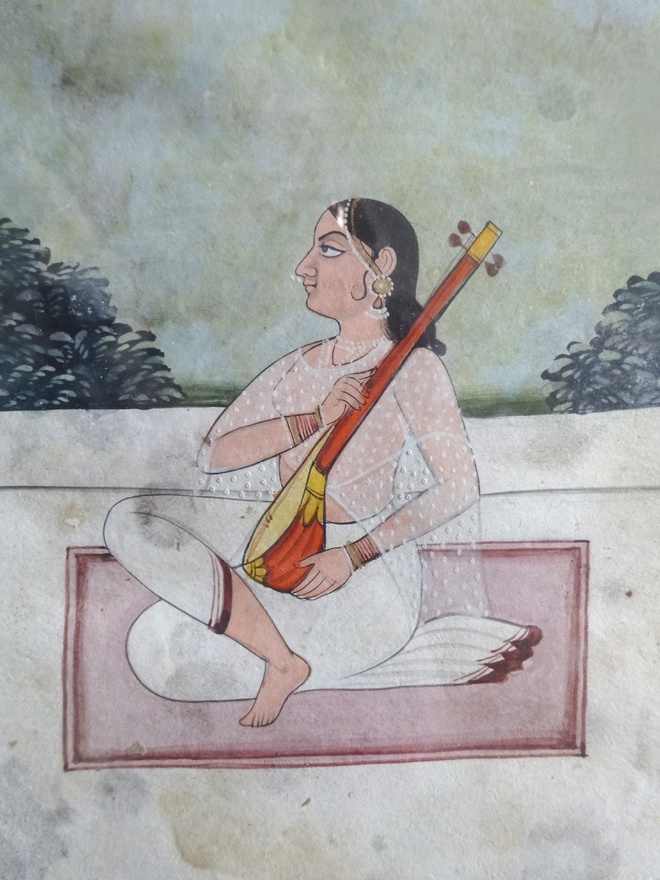
‘Portrait’ of a ‘Sakhibhava’ devotee, dressed as a woman
BN Goswamy
Having thoroughly searched the Shastras of former teachers, very hard to be crossed, the fortunate Sayana-Madhava has expounded them for the delight of the good. Let the virtuous listen with a mind from which all envy has been far banished; who does not find delight in a garland strung of various flowers?
— From the Prologue to the Sarva Darshan Sangraha
The fire is hot, the water cold, refreshing cool the breeze of morn; By whom came this variety? From their own nature was it born. — Cited by Madhavacharya

At the gracious home of Nona and Jyoti Datta, with whom I spent some days during my recent visit to the United States, I saw hanging on a wall — neatly framed and peering down benignly at everything — a group of paintings which I was instantly drawn to. Single figures of persons who could be seen as ‘men of God’ — sadhus, devotees, and the like — they all seemed to be absorbed in devotion, and all the images appeared to be related, as if coming from a series. There were other, more ambitious and complex, works on the walls of the home, but I was especially intrigued by this relatively simple, disarmingly artless, group of four. Unable to identify them at sight, I wanted to see if they carried any inscriptions on the back, or texts, and my hosts, generous as ever, agreed to my request. The frames were taken down and opened, and, to my delight, I found fairly detailed texts, all written in Persian, on the back of each, with a one line caption in poorly written Devanagari added at the top. If there was any doubt about whether they came from a series, it vanished naturally with this discovery, and I sat down: studying. There was no information in the texts that an art historian would ordinarily be happy to build on: names, dates, region, etc. The whole thing was a bit of a puzzle. One was left to one’s own devices.

unrelated to the series
But let me describe, briefly, the paintings. Each showed a devotee seated, all by himself, on a marble terrace, a small piece of carpet or asana under him, facing left. At the back could be seen an unadorned balustrade beyond which, in all but one case, appeared some foliage, symmetrically distributed, some bushes at the left and some facing them, at right. One devotee, grey-bearded, sat cross-legged, bare of upper body, lower part clad in a saffron dhoti, a necklace of black beads hugging his neck, the head sporting a turban with a peaked middle. In the extended right hand he held a small sacred text with some illegible writing on the open pages. Another painting, more meticulously done, featured a devotee of high station, a lightly coloured nimbus surrounding his head, back resting against a bolster, legs tucked under him, seated on a small carpet with a scrolling design. It looked like a conventional rendering of the great teacher,Vallabhacharya, founder of the sect dedicated to Krishna, now centred at Nathdwara, near Udaipur. The upper part of the body, bare in itself, was covered with a thin veil, and the lower part in a white dhoti with a small border. A distinctive aspect of the ‘portrait’ was the hair-style, a lush bunch of hair hanging, like a loose bun, at the back, touching the neck which had a kanthi encircling it. In one hand he was seen holding a small prayer-mala; by his side were wooden paduka-sandals which he had obviously taken off before sitting down at his prayers; at a short distance from the carpet was a brass vessel, clearly hinting at containing sanctified water.

A third ‘portrait’ was of an elegant-looking woman devotee, intent look on the face, gazing into the distance while playing on a stringed instrument that rested in her lap. Seated like a musician, her right leg crossed over the other knee; a thick mass of black hair trailed along her neck; pieces of jewellery adorned her form: a string of pearls that shone across the side of the head, connecting to finely detailed pendant earrings; a nose-ring featuring two pearls; a bank of bangles on both wrists. On the upper part of her body was draped a thin, transparent, veil of patterned muslin; the lower part of the body featured a dhoti; a thin wisp of curly hair seemed to kiss a cheek.
This is what I could see in the paintings. However, it was time to turn to the texts that were inscribed on the backs of the paintings. And when I started reading them, I found that I was completely wrong in interpreting at least two of the paintings. The figure that I thought was that of Vallabhacharya, was, according to the text, that of a ‘Gosain of Vrindavana’. But the far greater surprise for me was the text telling me that the woman devotee with the stringed instrument that I have described above was not a woman at all: it was the rendering of a man who belonged to the small sect of ‘Sakhibhavas’.

The text gave details: devotees belonging to this sect saw themselves as the beloveds of Krishna, and ‘surrendered’ themselves to Him in that role: dressing up as women, conducting themselves in daily life and speaking as women, adopting ‘the ways and wiles’ of women when facing an image of his. The text left no doubt about this. That, in different faiths, devotees refer to themselves as the ‘brides’ of God sometimes, I knew about. But here was a whole sect of men assuming that role.
In respect of style, I see these paintings as dating back to ca. 1800, and having been painted in a general North Indian style, possibly based in Lucknow or the areas around Agra and Mathura. But I am unable to guess what work the texts at the back of the paintings come from. Clearly it must have been a work which spoke of systems, and of categories of devotees. One thinks of that great 14th century text, the Sarva Darshan Sangraha, by Madhav Vidyaranya, who expounded on the 16 philosophical systems current in India at that time; what comes to mind also is Mohsin Fani’s celebrated 17th century work, the Dabistan-e Mazaahib, which again speaks of a number of Hindu sects practising their beliefs. But these brief texts were nowhere close to those works.
What then? I am still searching.
Join Whatsapp Channel of The Tribune for latest updates.



























